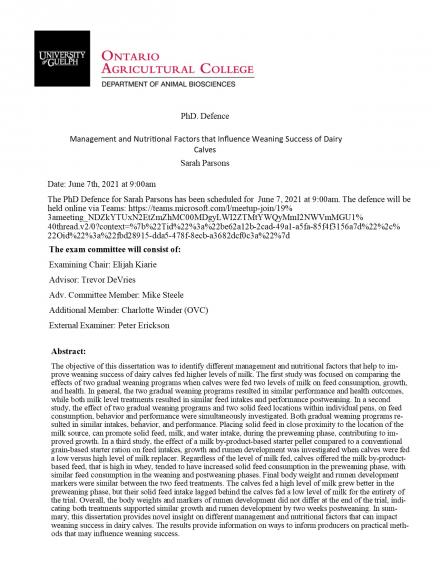Teams: https://teams.microsoft.com/l/meetup-join/19%3ameeting_NDZkYTUxN2EtZmZhMC00MDgyLWI2ZTMtYWQyMmI2NWVmMGU1%40thread.v2/0?context=%7b%22Tid%22%3a%22be62a12b-2cad-49a1-a5fa-85f4f3156a7d%22%2c%22Oid%22%3a%22fbd28915-dda5-478f-8ecb-a3682dcf0c3a%22%7d

The objective of this dissertation was to identify different management and nutritional factors that help to im-prove weaning success of dairy calves fed higher levels of milk. The first study was focused on comparing the effects of two gradual weaning programs when calves were fed two levels of milk on feed consumption, growth, and health. In general, the two gradual weaning programs resulted in similar performance and health outcomes, while both milk level treatments resulted in similar feed intakes and performance postweaning. In a second study, the effect of two gradual weaning programs and two solid feed locations within individual pens, on feed consumption, behavior and performance were simultaneously investigated. Both gradual weaning programs re-sulted in similar intakes, behavior, and performance. Placing solid feed in close proximity to the location of the milk source, can promote solid feed, milk, and water intake, during the preweaning phase, contributing to im-proved growth. In a third study, the effect of a milk by-product-based starter pellet compared to a conventional grain-based starter ration on feed intakes, growth and rumen development was investigated when calves were fed a low versus high level of milk replacer. Regardless of the level of milk fed, calves offered the milk by-product-based feed, that is high in whey, tended to have increased solid feed consumption in the preweaning phase, with similar feed consumption in the weaning and postweaning phases. Final body weight and rumen development markers were similar between the two feed treatments. The calves fed a high level of milk grew better in the preweaning phase, but their solid feed intake lagged behind the calves fed a low level of milk for the entirety of the trial. Overall, the body weights and markers of rumen development did not differ at the end of the trial, indi-cating both treatments supported similar growth and rumen development by two weeks postweaning. In sum-mary, this dissertation provides novel insight on different management and nutritional factors that can impact weaning success in dairy calves. The results provide information on ways to inform producers on practical meth-ods that may influence weaning success.

